#les pains de Picasso
Explore tagged Tumblr posts
Text


Robert Doisneau, Les Pains de Picasso (𝟣𝟫𝟧𝟤)
11 notes
·
View notes
Photo

“Les petits Pains de Picasso”,
Robert Doisneau, 1952
5 notes
·
View notes
Text
Edward G. Robinson, the Art Collector By Raquel Stecher
“I was hooked on art—an addict. The only thing real in the world seemed to be catalogs from dealers, galleries and museums.” - Edward G. Robinson
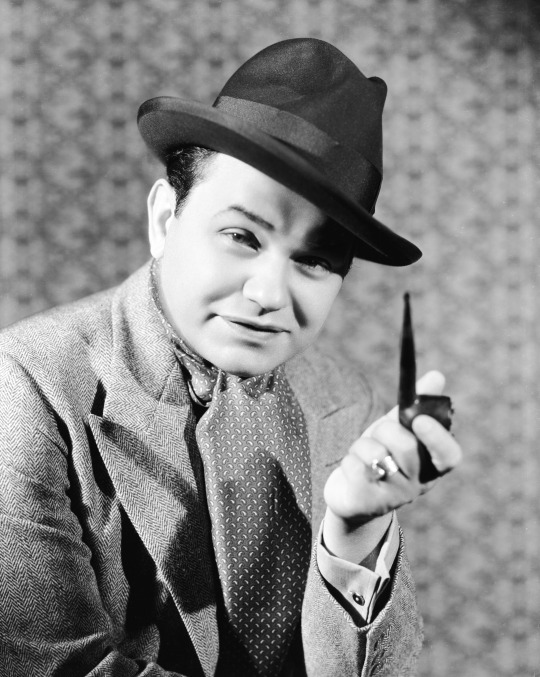
Edward G. Robinson, the cigar chomping star of such crime dramas as LITTLE CAESAR (’31), BULLETS OR BALLOTS (’36), KID GALAHAD (’37) and KEY LARGO (’48), was a gangster on screen but a refined art collector off screen. What began as a childhood fascination eventually blossomed into a full blown obsession. Robinson often joked that, “you don’t collect paintings, they collect you.” Over the years, Robinson collected over 70 works of art, mostly impressionist and post-impressionist paintings. Art was a lifelong passion of his, one he couldn’t just keep to himself but would share with anyone who would listen.
As a child, Robinson would cut pictures of paintings from magazines and add them to his scrapbooks. According to Robinson biographer Alan L. Gansberg, “he would find his way to museums and art galleries, look around, then head back to the Astor Library to discover, in books, what he had seen and why it was renowned.” Robinson’s love extended beyond just collecting, and he developed a pure love of curation. He wasn’t interested in status. And art dealers soon discovered that he couldn’t be swayed by suggestion or opinion. Robinson’s method of selecting his next acquisition was from pure instinct. If the piece spoke to him, he bought it. If it came with an intriguing backstory, even better.
In his autobiography All My Yesterdays, Robinson shares with readers his many art collecting adventures. He started off by purchasing reproductions which he would lovingly frame and hang on the wall or give to friends. His first real purchase was an oil painting entitled “Cow in the Meadow” which he bought for $2 at auction. Since he earned more money working in theatre and in Hollywood, Robinson caught the art buying bug. He’d visit public galleries and private collections in New York City, London and Paris. Robinson became known among art dealers, who would let him take home a painting for a month before purchasing.
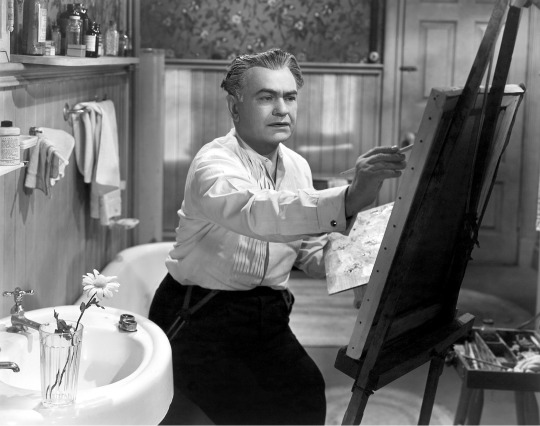
Robinson celebrated big milestones in his life with new art. In his memoir he wrote, “to mark suitably the birth of my son, I bought a good-sized Degas of two dancers and a lovely Pissarro — oh, such a lovely Pissarro — for $2,500 and a Monet painting of some willows for another $2,500.” Robinson fell in love with the work of Georges Rouault, Pablo Picasso, Titian, Francisco Goya, Vincent van Gogh, Paul Gaugin and others. He thought Rembrandt was overrated.
Notable pieces in Robinson’s collection included:
“Daughters of Revolution” by Grant Wood
“The Black Marble Clock” by Paul Cezanne
“Portrait of Père Tanguy” by Vincent van Gogh
“Young Girl with a Hat” by Pierre-Auguste Renoir
“The Artist’s Mother” by Edouard Vuillard
“L’Italienne” by Jean-Baptiste-Camille Corot
“Figure of a Woman (Before the Theater)” by Berthe Morisot
“Jane Avril Dancing”” by Henri de Toulouse-Lautrec
“View of Le Crotoy, from Upstream” by Georges Seurat
“The Vase of Flowers” by Georges Rouault
Over the years, Robinson worked directly with artists. In 1939, he commissioned a painting of himself, his wife Gladys and his son Eddie by Edouard Vuillard. After filming CONFESSIONS OF A NAZI SPY (’39), he took Gladys on a trip to Mexico where he met with Diego Rivera and bought several pieces. It was there that he met Frida Kahlo, who was not yet known in the states, and purchased four of her paintings for $200 each. According to artsy.net, “Robinson’s purchases were Kahlo’s first major sales, her first to an American, and gave her some financial independence.”
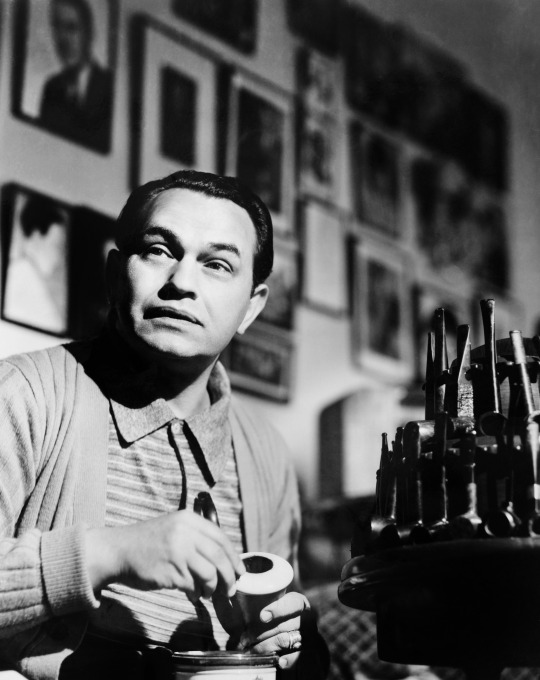
It wasn’t enough for Robinson to keep these pieces to himself. He felt that others should enjoy them too. When he bought a house in Beverly Hills, he petitioned the City Council for permission to build an adjoining gallery on the property. Once complete, he filled it with his prized possessions and opened the gallery to the public by hosting guided tours. Whenever a tour guide failed to show up, Robinson, his wife and even his butler would fill in. Robinson also exhibited his pieces elsewhere including collaborating with friend and fellow art collector Vincent Price on a museum show. In 1953, he loaned out 40 of his paintings for an exhibition at MoMA. The proceeds went to the museum’s New York City School Fund.
Robinson’s collection would diminish drastically when he had to sell 60 paintings as part of a divorce settlement. An auction was planned until Stavros Niarchos, a wealthy Greek shipping magnate, stepped in and bought the whole kit and caboodle privately for $3.5 million. It pained Robinson to lose so many of his darlings all at once. He eventually bought 14 of those pieces back from Niarchos and from other private collectors who purchased them after the original sale. Robinson was able to buy back some of his favorites from Cezanne, Renoir, Seurat, van Gogh and Gaugin. When Robinson remarried in 1958, he and his new bride Jane Robinson (nee Bodenheimer), a fashion designer who went by the name Jane Arden professionally, set out to build the collection back up again. A couple of years after Robinson passed away, Jane published a coffee table book called Edward G. Robinson’s World of Art as a way to pay tribute to Robinson’s lifelong passion.
#Edward G. Robinson#art#impressionism#post impressionism#vincent van gogh#picasso#TCM#Turner Classic Movies#Hollywood#Raquel Stecher
120 notes
·
View notes
Text
ILLUSION - SURREALISM
Analyse creative manipulation images.
1. Zdzislaw Beksinski
The canvas, known as "Creeping Death", evokes a lot of emotions and remains relevant all the time. The leitmotif is death, which creeps silently like a spider. This is how he appeared in the eyes of the painter - death comes unexpectedly and destroys everything on its way.
Beksiński's paintings were about loneliness and the inevitability of death. The painter also often presented a vision of Armageddon. This is also the case of "Creeping Death". The end of the world appears in dark, brown and bloody colors. And death takes its toll and disappears unnoticed from the battlefield. The city burning in the background means that death has won again. Nobody survived. Death can take many shapes, it can resemble a human, an animal or a spider. In the painting by Zdzisław Beksiński, he is a terrifying creature that leaves the ruined area on its cramped limbs. Instead of the face, you can see a bandage through which a blood stain pierces. Instead of a torso, there is a hairy abdomen, similar to that of deadly spiders, and they will always flee from impending danger. Just like death, which also has time to hide from fire.
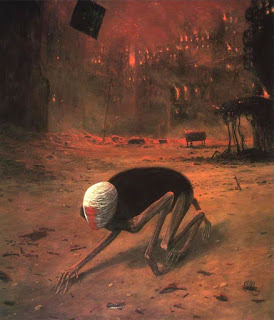
Beksiński's painting is one of the most terrifying contemporary works of Polish painting. Suffering, anger and resignation permeate them. The artist knows that he is unable to change his fate. He only has pain and the awareness that death will come for him. "Creeping Death" can be a universal picture, presenting the world after war, apocalypse or catastrophe. They can also be the darkest thoughts of every human being that circulate through the mind looking for an outlet. Because everyone is struggling with their own demons, which may appear completely different. It is certain that they cause fear, but they are essential in the fight against the suffering that is part of human life.
2. SALVADOR DALI
There are four clocks in the picture. One hangs from a dry tree, the other, with a blue shield and golden edging, flows down from a brown plinth. There is a fly on it, which can symbolize the "flying" and passing time. The orange watch lying next to it seems to be less soft and melting than the others. Ants crawled over him. The orange clock looks like it's about to be eaten by insects. Ants are here a symbol of rotting, decay. The fourth clock is in the center of the painting. It flows down from a deformed, beige-colored form. Only after looking closely you can see something like a nose, eyelid, long eyelashes. The distorted form resembles skin pulled from the face. According to some, it is a self-portrait of Salvador himself.

"Soft clocks" is nothing but a delicate, extravagant and lonely, paranoid-critical camembert of time and space.’’ Salvador Dali
Persistence of memory is perhaps one of the artist's most recognizable works. It was established in 1931. The idea was born when Dali, eating a melting French Camembert cheese, saw clock faces in it.
Dali created works that were supposed to amaze or shock. He did not represent anything directly, but through a vision. Therefore, he is included in the group of surrealists. Obraz Persistence of memory is a dream about time deformed by memories and dreams. Gala - Dali's muse and wife - said about this painting that the viewer's memory would only be the "softness" of the watches, because anyone who saw this work at least once would never forget it. The rocks of Cape Creus are an element of the landscape that appears in many of Dali's works. They have become an example of "hard" forms. The artist, who has a well-prepared drawing and knows the perspective, creates in a surprising way. An example is theoretically correctly painted clocks, but why is one of them hung over a branch, and the other running off the counter? It was this astonishment that the artist wanted to combine various objects in any way. The elements of the painting are arranged on the canvas in such a way that we have the impression of a large space and emptiness. Thanks to vivid imagination, all details have been divided into soft and hard. Clocks are among the soft ones.
3. RENÉ MAGRITTE
With my popular sympathy for the Belgian painter René Magritte, I have allowed myself to be introduced to you by opening the whole series "Art for Tuesday" with his "Lovers". Together with the blog returning to the expanses of the Internet, let Magritte be the patron of the reactivation of this cycle, this time with her "Son of Man".
The very title "Son of Man" (French: "Le fils de l'homme") is a bit puzzling when confronted with this picture presents itself.
After all, we see an elegant man in a suit and a bowler hat against the background of the wall separating him from the sea, above him there are clouds that announce a storm or storm. And what is very important - it is a self-portrait.
Oh yes, I would ... Before the face of forgotten people (levitating?) A green apple that makes his face invisible, revealing part of the eye and eyebrow in fact. We have to remind ourselves that the Belgian was definitely a surrealist who grew out of the impressionist school. However, he used his symbolic linguistic voice, which was shaped by such tragic experiences as the mother's suicide - hence the motive of the shroud. The motif of a veiled face, or the lack of it, is constantly present in Magritte's painting. Maybe it allows you to stay safe? For both the "covered" and those looking at him? Or maybe these masks and covers allow for proper perception of things (I refer to the author's painting "Rape")?
As for the "Son of Man", a stretched (as always), original interpretation appeared in my head.
The apple ripens with its apple tree represented by the man. He is well dressed, which can mean high social status. Or maybe an apple covering a man's face makes him anonymous? is it just a tree from which society grows? And when he dies, will someone eat the forbidden fruit that he has grown, and will continue this process? Another "Son of Man" ..?
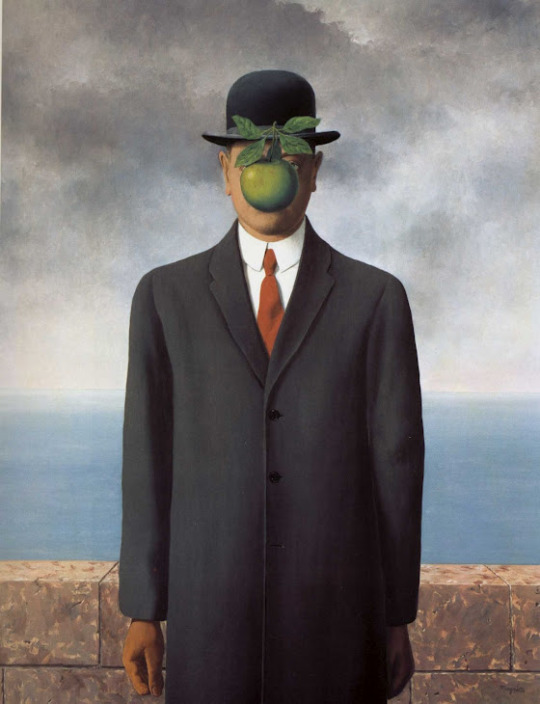
4. Max Ernst
"Day and Night" is a work that Max Ernst painted in the years 1941-1942. It presents a gloomy rocky landscape in dark colors. The image of the night is dominant here - the dark blue sky and the outlines of boulders. On the dark background, however, there are traces of the day, resembling daytime photographs of the same space. In these pictures these places appear completely different - they are sunny and full of bright colors. They do not resemble a barren night landscape.
Ernst's work follows surrealist poetics. Its meaning becomes understandable above all in the historical context in which it was created. It is about the tragedy of World War II, which left its mark on the artist's own biography. He miraculously managed to escape from the hands of the Gestapo and emigrate from France to the United States.
The night landscape is a barren land devoid of color and optimism. One gets the impression that we are dealing with a world completely destroyed by some cataclysm. His memories are only optimistic photographs from the past, which show the old face of the landscape. These optimistic incrustations in combination with the dominant gray and sterility not only do not cheer up the whole, but make it even more repulsive. We are dealing here with a world that will never return to its former glory.
The colorful pictures bring to mind illustrations from children's books. Thus, the artist refers to the myth of childhood as a lost paradise. Children's dreams are triggered here, in which reality seems to be a magical and wonderful being. At the same time, the juxtaposition of colored fragments with a gloomy background is also associated with the biblical Eden, where innocence and beauty are destroyed by sin and evil.
You can also understand "Night and Day" as a kind of puzzle. The picture resembles a puzzle that needs to be matched in an appropriate way so that they form a whole together. In this sense, one should see in Ernst's work traces of hope for rebuilding what was destroyed during the war. It is, in a way, a proposal to organize the world once again so that it becomes a place where a person feels safe again.
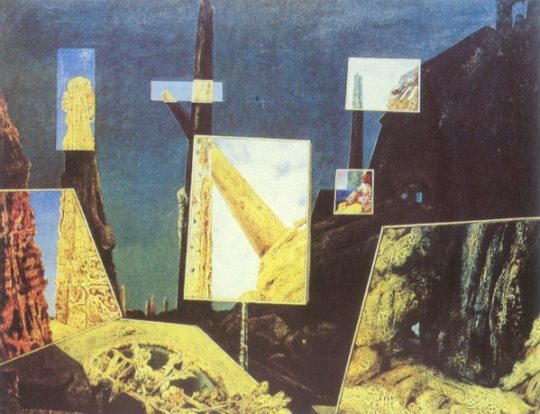
5. Pablo Picasso
"Guernica" is a famous painting by Pablo Picasso, painted in 1937 in reaction to the Spanish Civil War. The work is an act of protest against violence and at the same time a great manifestation of pacifism.
The title of the painting comes from the name of a Spanish city bombed by the German Luftwaffe air force in response to resistance to General Franco's group.
"Guernica" shows deformed human and animal figures, forming a chaotic swirl. You can see the bodies in pieces, especially the heads and limbs. The severed hands tighten tightly on the objects they hold: a candle or a sword. The mouths of the characters are usually open in a silent scream, and terror is visible in their eyes. People seem to squirm in deathly groans. Human figures blend with animals.
The whole thing looks like a huge, dynamic swirl. The depressing impression is deepened by the colors of the painting, in shades of black and gray. The central part of the painting is lit by a light bulb in the upper edge of the work. It seems that the situation depicted in the picture takes place in a narrow room, intensifying the impression of being surrounded and threatened.
The painting was painted in cubist aesthetics, which in the case of such a dramatic topic emphasizes the cruelty and tragedy of war. The fragmentation of the solid is here not only an act of artistic deformation, but also emphasizes the essence of any armed conflict, which is the total destruction of the world.
The war appears on Picasso's canvas as unbridled chaos and suffering. People dehumanize, they are reduced to the level of terrified animals, driven by the survival instinct. Human remains are clearly deformed, they resemble meat. Human and animal bodies are fragmented as if after a bomb had exploded.
The symbol of destruction is the Spanish bull emerging from the gloom, which covers the unfolding events with an unshakable gaze. Broken hands clutch at useless objects, among which stand out a candle and a broken sword. The former may symbolize the desire to illuminate the escape route, but it is also a sign of mourning for those who died. A broken sword and a torn horse indicate the uselessness of conventional weapons in a modern war that brings mass death and destruction.
Picasso's painting exudes an atmosphere of fear and terror, the image of a mother lamenting over a child's corpse is particularly poignant. The claustrophobic narrowness of the room in which the characters find themselves emphasizes the non-exit character of their situation.
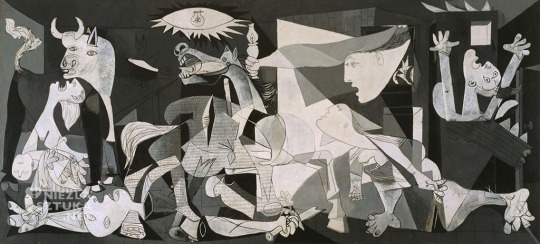
6 notes
·
View notes
Video
youtube
MARDI 8 DECEMBRE 2020 – (Billet 1 / 3)
Le 15 décembre, si tout va bien (mais aux Infos d’hier, c’était pas gagné !), le Club Med ouvre 10 Villages. Si 9 sont situés à l’autre bout du monde, plus près de nous, dans le lot, IL Y A MARRAKECH !!!
Et, comme par hasard, beaucoup d’articles sont publiés sur le Net, à la fois sur le Club Med de Marrakech (« La Palmeraie ») mais aussi, et surtout, sur Marrakech.
Un grand nombre d’entre eux concernent la ré-ouverture de La Mamounia. Voir la petite vidéo ci-dessus (1min. 21) et lire l’article que nous avons reproduit ci-dessous, accompagné de quelques photos.
Si certains pouvaient nous « reprocher » le côté un peu trop « publicitaire » de nos compliments sur le Club Med, ils pourront rajouter ceux qu’on a faits, faisons et ferons sur cette ville MAGIQUE qu’est Marrakech. Nous assumons tout !
Alors, il n’est pas dit qu’entre la fin du mois de janvier et la première quinzaine de février nous n’allions pas passer une petite semaine là-bas. Cette fois-ci, lors d’une de nos sorties, nous délaisserons le Royal Mansour (qu’on aime beaucoup aussi) pour La Mamounia et y déguster, en buvant un verre de thé à la menthe, une création exclusive de l’hôtel : la « Corne de Gazelle made by Pierre Hermé ».
Enfin, pour finir, un dernier point (découvert dans un article) : La Mamounia est le seul Palace au monde dont le genre est féminin. Nous trouvons que cela méritait d’être signalé.
____________________________
« 5 RAISONS DE RETOURNER A LA MAMOUNIA, le plus beau palace de Marrakech » (article publié le 18 novembre 2020 dans la revue « AD Magazine »)
Après plusieurs mois de travaux, la grande dame de Marrakech a fait peau neuve sous l’impulsion du duo de designers « Jouin Manku ». Immersion au cœur de La Mamounia, « LE » palais légendaire de la ville ocre où il fera bon poser ses valises à la fin du confinement…
À l’origine des rénovations de La Mamounia, Patrick Jouin et Sanjit Manku – duo créatif de l’agence de design d’espace « Jouin Manku » –, confient que ce projet a été « un cadeau ». En relevant le défi d’apporter une nouvelle énergie au Palace, les designers ont respecté le charme et l’histoire des lieux. Avec délicatesse, ils ont compris et enrichi l’artisanat marocain de savoir-faire locaux, italiens, français et espagnols.
De la nouvelle allée Majorelle créée dans les jardins jusqu’au lobby en passant par les restaurants de l’hôtel, le tandem a repoussé les limites de la création précieuse. Au restaurant asiatique par exemple, « Jouin Manku » a imaginé un décor typiquement marocain mêlant fauteuils en laque noire, murs tendus de tissu et lanternes traditionnelles dessinées sur mesure.
C’est le chef triplement étoilé, Jean-Georges Vongerichten, qui dirige le nouveau restaurant asiatique (s’inspirant de la gastronomie thaïlandaise et des saveurs pimentées, le chef y travaille les citrus, les poissons locaux comme le Saint-Pierre ou le bar mais aussi les sushis et les sashimis frais)… et le restaurant italien, une trattoria de luxe présentant le meilleur de la Botte, des spécialités italiennes alléchantes et une terrasse arborée avec vue sur la piscine, en retrait, et les jardins merveilleux du palace – un écrin enchanteur garni d'oliviers centenaires et de milliers de rosiers.
Surnommé par le directeur de La Mamounia le « Picasso de la pâtisserie », Pierre Hermé devient le directeur artistique et culinaire du salon de thé. Avec ses allures de Riad, le salon de thé mêle assises en cuir tressé, murs tendus de tissus aux accents bleutés et vitraux, le point d’orgue de l’espace étant le lustre grandiose dessiné par « Jouin Manku ». À la carte, des assiettes salées comme le pain perdu au curry et au curcuma ou le lobster roll, mais aussi une corne de Gazelle créée pour La Mamounia, dont le croustillant amlou (une préparation culinaire berbère) rencontre une belle pâte d’amande à la fleur d’oranger et une crème à l’amande grillée.
Et pour la première fois, La Mamounia propose aux clients de l’hôtel la possibilité de visionner des films installés dans un salon-cinéma – une occasion par exemple de revoir « L’homme qui en savait trop » que Hitchcock a tourné dans ces lieux. Pensé comme un espace feutré et intimiste, on y accède en passant par le bar Churchill, repaire par excellence des habitués, entièrement redécoré par « Jouin Manku » lui aussi.


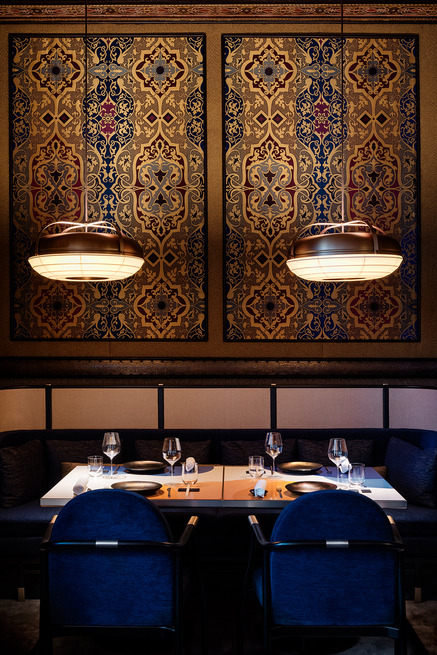


2 notes
·
View notes
Text
La tête au carré

Comme tous les matins, je me suis levé en grognant, encerclé d’une brume qui m’empêchait d’ouvrir les yeux. Je déteste me réveiller mais surtout quitter le lit. Je n’ai pas fait attention en passant devant le miroir, ou alors, c’est arrivé un peu après. C’est pendant que l’eau du thé était en train de bouillir et mon envie de pipi, en sortant des toilettes que j’aperçus mon reflet et fus terrifié en découvrant que ma tête avait changé. Je regardai la chose en forme de plusieurs cubes qui la remplaçait. Dessus je cherchai mes yeux, ma bouche, mon nez ainsi que me oreilles. Seulement, je n’arrivai pas à les trouver, tâtant du mieux possible en vain ces carrés difformes aux couleurs agressives. Je sentis la panique monter en flèche ; j’étais perdu ne comprenant quel terrible sort m’a été jeté. Accroupis, je touchai des doigts mon visage qui pourtant semblait visible de mes yeux, d’ailleurs, en louchant, je pouvais voir mon nez. Je me levai de nouveau pour regarder mon portrait dans le miroir. Il avait bien été censuré transformé en une espèce de multiples carrés. Je fus dégouté. En m’éloignant, je me sentis rassuré de voir le reste de mon corps entier dans la glace. Mes mains, mes épaules gardaient leur aspect d’origine. Je ne remarquai pas la sonnerie du téléphone ni celle de la bouilloire. J’étais vraiment perdu.
Dans la salle de bain, je rinçai mon visage avant de revoir cette horreur dans la glace au-dessus du lavabo. Je ne comprenais pas comment je pouvais sentir, respirer ou parler sans être gêné. J’avais beau passer mes doigts sur chaque partie de ma tête, je ne trouvais rien de mes orifices naturels. De même, mon reflet ne présentait aucune différence dès que je commençais à m’exprimer ou souriais. Je ne vis pas non plus ma dentition. Cela me fit douter du reste. Je pus toutefois manger un morceau de pain. Je vis alors la mie entrer dans le plus grand des carrés placé au centre qui resta toujours immobile pendant la mastication. Je regardai encore ma tête qui avait l’air d’un Picasso quand la porte d’entrée s’ouvrit avec fracas.
Bien qu’elle n’habitât pas avec moi, mon amie avait la clé de la maison. Elle commença à m’appeler d’une voix paniquée, elle bafouillait expliquant qu’il lui est arrivé quelque-chose d’horrible. Je descendis en demandant si c’est plus horrible que pour moi. Elle tourna de l’œil s’écroulant sur le sol comme un château de carte. Après quelques secondes, elle reprit ses esprits. Je racontai ma version, elle demeura silencieuse, impressionnée par le brutal changement de mon visage. Elle avoua ne pas savoir comment me regarder. Puis, elle expliqua la raison de sa venue commençant à se déshabiller. « C’est différent mais presque pareil. J’ai découvert ça en prenant ma douche » dit-elle. En effet, sur sa poitrine ainsi que son pubis, une forme opaque était venue se coller déformant ses parties intimes. Je ne vis rien de ses seins cachés ni de son pubis, rappelant le floutage de Canal+ des années quatre-vingt. C’était absurde. Comme moi, elle affirma qu’elle pouvait voir les zones censurés sans problème mais ne ressentait rien quand elle y touchait. J’approchai et sans prévenir, je serrai son sein gauche, jouant légèrement à le presser et pincer le téton. Elle me regarda avec ses grands yeux bleus écarquillés. « Non, rien ! » dit-elle en soupirant de dépit. Puis, elle prit ma main et frotta son sexe, je vis mes doigts entrer dans ce rectangle nébuleux. Je pus enfoncer un doigt, reconnaissant au toucher la fente délimité par ses lèvres roses. Elle me regarda avec un air triste et désabusée. « Je suis désolée, mais je ne ressens vraiment rien. » Cette sensation fit perler une larme sur sa joue rouge de colère.
Je retournai dans la cuisine et lui proposai de trouver une explication sur internet tout en prenant le petit-déjeuner. Elle s’assit et commença à scruter son smartphone pendant que je préparai la table. Puis, je récupérai mon ordinateur. D’habitude, je déteste manger à côté, seulement nous étions dans un cas de force majeur. Je ne trouvai rien visitant différents moteurs de recherche. Ma copine s’énervait à ne rien trouver. Son pied tapait sur le sol sur un rythme rapide et agressif. Elle marmonnait régulièrement se sentant envahie par l’exaspération et l’impuissance. Quant à moi, j’essayai de la rassurer par des mots doux et simples. Je remarquai toutefois, qu’elle évitait mon regard. En fait, je ne réalisai pas que je n’en avais plus.
Au bout d’une petite heure et une centaine de lectures inutiles, je trouvai enfin un site expliquant le syndrome dont nous étions atteints. Je n’y croyais pas. C’était un site débile sur des théories du complot. D’après l’auteur du reportage, nos webcams auraient scanné nos rétines et permis aux diffuseurs internet de censurer des visages réels grâce à une nouvelle technologie qui touche le subconscient. Grace aux scans, ils pouvaient entrer dans notre mémoire pour la déformer ou bloquer certaines parties. Ainsi nous devenions des objets, des photos et non plus des êtres humains à part entière. Je n’y croyais pas, mais mon amie lit un article très récent parlant de personnes censurées. Nous allumâmes la télévision découvrant ainsi que nous n’étions pas les seuls atteints. Des hommes, des femmes marchaient dans la rue avec le visage flouté ou remplacés par des carrés. L’un d’eux s’exprima en direct, hurlant au scandale d’avoir été ainsi censuré. Puis le reporter dont le visage avait aussi changé annonça que cette pratique était digne des plus grandes dictatures. Je ne partis pas travailler, nous restâmes toute la journée à écouter les informations en boucle, les médias relayaient débats sur débats. Les personnes touchées avaient soit postés des photos ou des images intimes, soit montrés un intérêt pour la pornographie. Les puritains applaudissaient voyant en cette censure un signe fort de la morale divine ; les autres, énervés, appelaient à manifester contre cette étrange interdiction. Toutefois, des propositions furent notifiées.
Quand ils expliquèrent comment se débarrasser de son floutage, elle me regarda persuadée que je n’accepterai pas. Il suffisait simplement de nous marier et d’avoir des enfants. Ainsi, les seins d’une maman n’étaient pas censurés. Je trouvai le procédé ignoble et signalai qu’il n’en est pas question. Puis, je demandai si elle épouserait une tête au carré. Elle se mit à rire en disant : « Certainement pas ! ». Nous continuâmes à écouter les propos passant aux informations. Certains pays moins démocratiques utilisèrent ce procédé pour reconnaitre les pervers et les arrêter. Mais l’opinion publique criait au scandale bien que des lynchages eurent lieu dans des villes occidentales. En fin d’après-midi, sans être prévenu, nous retrouvâmes notre apparence. Elle regardait avec des yeux pétillants mon visage. Elle écarta le col de son pull pour regarder sa poitrine et souffla en découvrant que le floutage avait aussi disparu. Rassurés, nous pûmes revivre correctement.
Accusés de faire du zèle, les gouvernements se défendirent en ordonnant des restrictions d’internet. De leur côté, les grosses entreprises de service technologiques expliquèrent cet ‘incident’ à cause d’un opportun qui voulait déstabiliser la bonne société. On pointa le doigt vers la Russie, la Corée du nord, l’Inde ou les Etats-Unis. On désigna le fauteur de trouble, l’inventeur de ce procédé, un douteux hacker russe ou japonais à la solde des services secrets d’un pays suspecté. Comme d’habitude, tout le monde nia. Comme d’habitude, on avait montré qu’on a la plus grosse technologie aux autres nations au détriment des gens qui ne sont riens comme vous et moi.
Alex@r60 – février 2020
Tableau de Charmion Van Wiegand (1899-1983) Stone vintage (Amethyst evening New York) 1951
23 notes
·
View notes
Text
BD, comics et mangas : nos nouveautés de septembre.
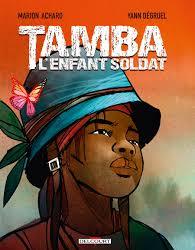
Tamba, l’enfant soldat, de Marion Achard et Yann Dégruel :
Dans un village d'Afrique, les gens se rassemblent dans un bâtiment pour une audience dirigée par la Commission de Vérité et Réconciliation. Au centre, le jeune Tamba, 16 ans, est invité à témoigner de sa participation aux violations des Droits de l'homme dans ce pays qui se remet difficilement de la guerre qui cherche à comprendre et à pardonner pour se reconstruire. Tamba : "J'avais huit ans lorsqu'on m'a kidnappé..."

A Silent Voice, tome 3, de Yoshitoki Oima :
A la grande surprise de Shoya, Shoko a accepté de renouer contact avec lui, et à force de tenter comme il le peut de réparer les pots cassés du passé, il se lie peut à peu d'amitié avec la jeune fille, mais aussi avec Tomohiro, un camarade de classe exubérant, mais franc, et Yuzuru, la petite soeur de Shoko auprès de laquelle il a réussi à se faire accepter malgré les horreurs commises dans son enfance. Celui qui voulait mettre fin à ses jours a pris une autre voie sans s'en rendre compte, celle de la reconstruction, au point d'avoir désormais un téléphone portable qui lui sera extrêmement utile, ne serait-ce que pour communiquer avec Shoko. Mais ce qu'il souhaite par dessus tout, c'est reconstruire l'enfance brisée de Shoko, lui rendre le bonheur qu'il lui a volé. Et cela passe par une reprise de contact avec ses anciens camarades de classe du primaire, en tête Miyoko, la fillette qui était venue en aide à Shoko à l'époque où elle était martyrisée et qui a dû changer d'école à cause de ça, et la peste Naoka. Seulement, les choses se dérouleront-elles aussi bien que le souhaite le jeune garçon ?
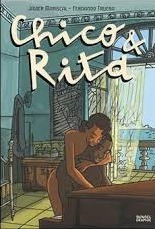
Chico & Rita, de Fernando Trueba et Javier Marsical :
Cuba, 1948: Chico aime Rita. Rita aime Chico. Mais les aléas de la gloire les séparent. Les jeux de l'amour et du hasard se nouent sur un tempo de jazz afro-cubain. Un roman graphique langoureux qui signe le retour du grand Mariscal sur le devant de la scène BD.
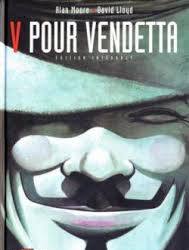
V pour Vendetta, d’Alan Moore et David Lloyd :
1997 : une Angleterre qui aurait pu exister... Dirigé par un gouvernement fasciste, le pays a sombré dans la paranoïa et la surveillance à outrance. Les «ennemis politiques» sont invariablement envoyés dans des camps et la terreur et l'apathie règnent en maître. Mais un homme a décidé de se dresser contre l’oppression. Dissimulé derrière un masque au sourire énigmatique, il répond au nom de V : V pour Vérité, V pour Valeurs... V pour Vendetta !
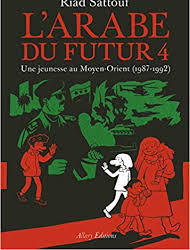
L’Arabe du Futur, tome 4 : Une jeunesse au Moyen-Orient (1987-1992), de Riad Sattouf :
Ce quatrième tome du succès mondial L'Arabe du futur couvre les années 1987-1992…Âgé de neuf ans au début de ce volume, le petit Riad devient adolescent. Une adolescence d'autant plus compliquée qu'il est tiraillé entre ses deux cultures – française et syrienne – et que ses parents ne s'entendent plus. Son père est parti seul travailler en Arabie saoudite et se tourne de plus en plus vers la religion... Sa mère est rentrée en Bretagne avec les enfants, elle ne supporte plus le virage religieux de son mari. C'est alors que la famille au complet doit retourner en Syrie...

Tamara Drewe, de Posy Simmonds :
Avec son nez refait, ses jambes interminables, ses airs de princesse sexy, son job dans la presse de caniveau, ses aspirations à la célébrité et sa facilité à briser les cœurs, Tamara Drewe est l'Amazone urbaine du XXIᵉ siècle. Son retour à la campagne, dans le village où a vécu sa mère, est un choc pour la petite communauté qui y prospère en paix. Hommes et femmes, bobos et ruraux, auteur à gros tirage, universitaire frustré, rock star au rancart, fils du pays, teenagers locales gavées de people, tous et toutes sont attirés par Tamara, dont la beauté pyromane, les liaisons dangereuses et les divagations amoureuses éveillent d'obscures passions et provoquent un enchaînement de circonstances aboutissant à une tragédie à la Posy Simmonds, c'est-à-dire à la fois poignante et absurde. Librement inspiré du roman de Thomas Hardy, Loin de la foule déchaînée, un portrait à charge délicieusement cruel et ironique de l'Angleterre d'aujourd'hui.
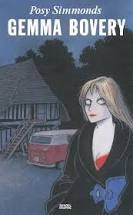
Gemma Bovery, de Posy Simmonds :
Exaspérée par l’intrusion incessante dans sa vie des enfants et de l’ex de Charlie, son nouveau mari, Gemma Bovery décide de quitter Londres et de partir s’installer avec lui dans un romantique cottage du bocage normand. Dans un premier temps, c’est la découverte émerveillée des charmes de la French Way of Life. L’existence simple et paisible, les voisins avenants, l’authenticité des choses, le pain merveilleux de Joubert, le boulanger intello de Bailleville. Mais l’exotisme a ses limites. L’argent manque. L’ennui guette. Charlie se laisse aller. Le joli cottage suinte l’humidité. L’authenticité se révèle frelatée et les voisins moins plaisants que prévu. Alors, Gemma prend un amant, sous l’œil inquisiteur de Joubert qui s’improvise chroniqueur de sa déchéance amoureuse. Si le décor, le destin et le nom de l’héroïne nous rappellent quelqu’un, ce n’est en aucun cas fortuit.

Un jour au musée avec les Bidochon, de Bidet :
Raymonde Bidochon, par on ne sait quel miracle, est parvenue à traîner son rustre de mari dans un musée! Le choc culturel est total. Comment va réagir Robert en découvrant les toiles de Picasso, Degas, Bacon, Manet, Soulages ou Bruegel, entre autres? C'est ce que vous découvrirez en lisant ce livre. En association avec les musées des Beaux-Arts de Caen et de Lyon, Binet nous régale des réactions des Bidochon face à ces toiles de maîtres, magnifiquement reproduites. 20 tableaux prestigieux, exposés dans ces musées, ont été choisis par l'auteur, qui a ensuite dessiné les réactions de ses personnages. Et leurs conservateurs nous éclairent aussi sur le contexte historique et de manière ludique.

Le Gourmet solitaire, suivi de Les Rêveries d’un Gourmet, de Jirô Taniguchi :
On ne sait presque rien de lui. Il travaille dans le commerce, mais ce n'est pas un homme pressé; il aime les femmes, mais préfère vivre seul; c'est un gastronome, mais il apprécie par-dessus tout la cuisine simple des quartiers populaires... Cet homme, c'est le gourmet solitaire. Depuis sa première déambulation en 1994, il a conquis, au fil de deux décennies de flâneries propices à des expériences culinaires précieuses et intimes, un public japonais et occidental toujours grandissant. L'intégralité de ses trente-deux repas est ici réunie pour la première fois.
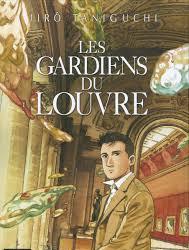
Les Gardiens du Louvre, de Jirô Taniguchi :
Au terme d'un voyage collectif en Europe, un dessinateur japonais fait étape en solitaire à Paris, dans l'idée de visiter les musées de la capitale. Mais, cloué au lit de sa chambre d'hôtel par une fièvre insidieuse, il se trouve confronté avant tout à une forme de solitude absolue, celle des souffrants en terre étrangère, privés de tout recours immédiat au cœur de l'inconnu. Alors que le mal lui laisse quelque répit, il met son projet à exécution, et se perd dans les allées bondées du Louvre. Très vite, il va découvrir bien des facettes insoupçonnées de ce musée-monde, à la rencontre d’œuvres et d'artistes de diverses époques, au cours d'un périple oscillant entre rêve et réalité, qui le mènera pour finir à la croisée des chemins entre tragédie collective et histoire personnelle.

Venise, de Jirô Taniguchi :
Un homme arpente Venise hors des sentiers touristiques, sur les traces de son histoire familiale. Il se surprend parfois à flâner, se perd le long des canaux, s'arrête pour observer. A mesure que les brumes du passé se dissipent, c'est une nouvelle cartographie de la Sérénissime qui se dessine: contemplative et intrigante, majestueuse et intime…
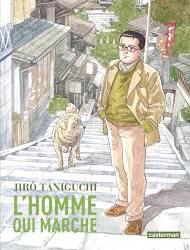
L’Homme qui marche, de Jirô Taniguchi :
Qui prend encore le temps, aujourd’hui, de grimper à un arbre, en pleine ville? D’observer les oiseaux, ou de jouer dans les flaques d’eau après la pluie? D’aller jusqu’à la mer pour lui rendre un coquillage dont on ne sait comment il est arrivé chez soi? L homme qui marche, que l’on apprend à connaître à travers ses balades, souvent muettes et solitaires, rencontre parfois un autre promeneur avec qui partager, en silence, le bonheur de déambuler au hasard…

Furari, de Jirô Taniguchi :
A la fin du XVIIIe siècle, un homme arpente Edo, l'ancienne Tokyo, avec pour ambition de cartographier la capitale, pas après pas. Dix sun font un shaku, six shaku font un ken, soixante ken font un chô, trente-six chô font un ri. Mais si ce marcheur s'efforce, par rigueur scientifique, d'adopter le pas le plus régulier possible, son entreprise se mue bien souvent en flâneries émerveillées face à la beauté de la ville, en observation curieuse de ses habitants, en haltes gourmandes le long des rues, et en rêveries qui lui font redécouvrir les paysages à travers les yeux d'un oiseau, d'une tortue ou d'un chat…
#bd#comics#manga#nouveautés#nouveautés septembre#scénariste : marion achard#dessinateur : yann dégruel#autrice : yoshitoki oima#scénariste : fernando trueba#dessinateur : javier mariscal#scénariste : alan moore#dessinateur : david lloyd#auteur : riad sattouf#autrice : posy simmonds#auteur : pierre binet#auteur : jirô taniguchi
4 notes
·
View notes
Text
Le Meriden Paris Hotel
How to choose Paris Lodging Here is a hotel you may want to go and stay at in Paris. It is called the Le Meriden Mantprmasse. At this particular hotel many famous people have stayed.
Many famous people go to Paris to get away or go to do shows at this hotel. There have been many famous people Like B.B. King, Cab Calloway, Fats Domino, Lionel Hampton and many more. This hotel has 953 rooms, and is Paris’s four-star hotel. The hotel is a good one to stay at, since you can tell all your friends back home that you stayed in Paris’s famous lodging arenas. The first-class hotel is minutes away from the Eiffel Tower. The Luxembourg Gardens is near the hotel as well.
This hotel has a bowling alley in it as well as a fitness center. The hotel has non-smoking rooms for those who do not smoke. The hotel also has a gourmet restaurant. In addition, if you want to go for a midnight stroll down the streets of Paris, do not sweat the kids in the hotel sleeping. The hotel has a babysitter in-house to assist you.
Choices of travel: The hotel also has dry cleaning services for those that need it as well as a meeting room. If your wondering about how you are going to get around, don’t sweat it. The grand hotel is a hop, skip and jump from the train station. If you don’t want to travel via train, take the subway, which is also close to the hotel.
How to choose activities: The hotel is near the Exhibit Center. If you are not interested in exhibits, you can choose from over 700 hotels to visit. Inside the hotels, you will have a wide selection of activities and entertainment. Most hotels in this area are 3, and 4-star lodging.
Some of the hotels are smaller than others are; yet, Paris has a few hotels that have over a thousand rooms. Inside most Paris, hotels are swimming pools. The family and children perhaps would enjoy an evening dip. In many hotels in Paris, you also have hot tubs. Hot tubs are idea for relaxing and relieving pain after a long day of sightseeing.
How to choose other activities: Paris has a wide selection of Exhibits shown in various museums. Around Paris you have the choice of visiting Centre Pompidou, Musée du Louvre, Musée de Rodin, Musée d’ Orsay, Musée National Picasso, Arc de Triomphe, Panthéon, Crypte Archéologique de Notre-Dame, Châteaux de Versailles, and so on. You can also take a river cruise on the Bateaux Parisians.
How to obtain passes: If you intend to visit several areas in Paris, it is best to purchase passes. You can find day passes for two adults online for as little as £69.
Pay an addition £19 for the children. Four adults passes combined with four children passes costs £128. You can also find five-day passes for both children and adults, i.e. ten people for £191. The passes provide you with free entry to attractions and includes benefits. Children 12 and under are often permitted entry to many museums in Paris.
Paris also has the Villa Savoye, Roué Libre, Sainte Chapella, and more to select from a list of museums. In addition, you have a selection of Hard Rock Cafés, Galleries, Department stores, and ore when visiting Paris.
One of the interesting areas to visit in Paris is the Musée des Egouts. This museum is called the sewer, since the establishment is actually inside a sewer. The museum is a bit smelly, yet it takes you through a journey in Paris’s history. You will learn about Paris’s waste treatment and water supplies, as well as other historical realities.
0 notes
Text
Surrealism and Animation

The surrealism movement was founded in Paris by some writers and artist who wanted to use people’s subconscious minds to unlock their imagination. The movement was strongly influenced by Sigmund Freud.
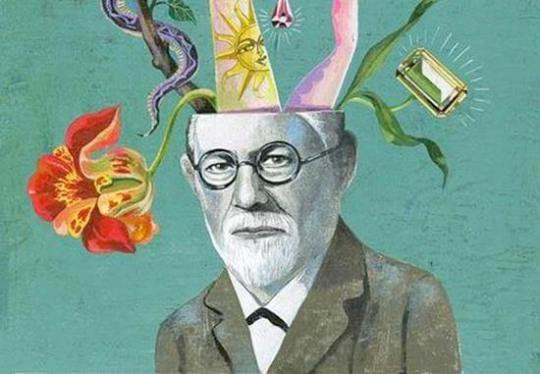
The surrealists themselves thought that the unconscious mind blocked people’s imaginations. By the surrealists basing their ideas on the power of the imagination, this indicated that they were influenced by the traditional Romanticism movement, whose key ideas were based on emotions and intuitions. However, the surrealists were radically different from the romantics because they had the theory that the revelations may be found to be on the streets and in everyday life.

One of the main founders of the Surrealist movement was Andre Breton, when he wrote “Le Manifeste du Surrealism”, where he famously wrote the definition of surrealism, which is “physic automatism” in its pure state, by which one proposes to express – verbally, by means of the written word, or in any other manner – the actual functioning of thought”.
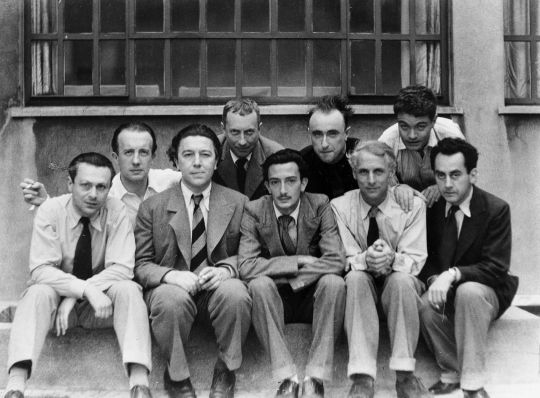
The Paris surrealists, 1933: Tristan Tzara, Paul Éluard, André Breton, Hans Arp, Salvador Dalí, Yves Tanguy, Max Ernst, René Crevel and Man Ray.
Fida Kahlo
Her paintings tried to show the attributes of a bad situation.
Mexican culture and Amerindian culture tradition are important in her work, which has been sometimes characterized as naïve art or folk art.
She frequently included the symbolic monkey. In Mexican mythology, monkeys are symbols of lust but Kahlo portrayed them as tender and protective symbols.

In 1938 Andre Breton, principal initiator of the surrealist movement, described Kahlo’s art as a ‘ribbon around a comb’.
When painting Christinci, Frida’s health improved and darkness and gloomy feelings improved. Around this time, Frida called her husband down from the scaffolding to come and see her work. He told her to go home and paint and that he would tell her later what he really thought of it. The following Sunday, he told her that she had talent. She appeared in one of her murals which paid testimony to her developing political awareness. Her mother disapproved of her husband because he was an atheist. Her parents thought it was a marriage between an elephant and a dove.

My dress hangs there, 1933
To Frida the US was ‘ugly, dull and drab’. She once said to Detroit automobiles – anything mechanical meant bad luck and pain. Another comment she made about life in the USA was in the painting ‘My dress hangs there’; Frida’s costume hangs amidst the chaos of the USA and its technology.

Henry Ford Hospital, 1932
Her most dramatic miscarriage was in 1932. During 13 days in hospital, she said she wanted to die. The monkeys and parrots often seen in her paintings are substitutes for her children.
Salvador Dalí
Dalí is one of the most famous & prolific artist of the twentieth century he is mostly remembered for his paintings, however, during his lengthy career, he also turned to sculpture, printmaking, fashion, advertising, writing, and most famously his work in film-making with Luis Bunuel and Alfred Hitchcock.
youtube
Dalí tried to convey the themes of sexual desire, death and decay; this is clear throughout his work. He also illustrated his knowledge and understanding of Freud’s psychoanalytical theories of his time. His work reflected his learning experiences and childhood memories. Dali’s work often included already accepted symbolism such as fetishes, animal imagery and religious symbols.

Sueño causado por el vuelo de una abeja alrededor de una granada un segundo antes del despertar, 1944
He also accepted the surrealist André Breton’s theory of automatism, which is the theory of tapping the unconscious mind. Dalí referred to this as ‘critical paranoia which is where ‘one could be delusional while maintaining one’s sanity’. This was also defined by Dalí as a form of irrational knowledge. This method is apparent throughout most of his fellow surrealist work and his own surrealist work as well.
During his mature period, he began experimenting with a Cubist style due to his influence from Pablo Picasso, who he met in Paris in 1929. This exhibition explored symbolism and his passion for the sub-conscious.
For the next several years Dali’s paintings illustrated his theories about the psychological state of paranoia and its importance as subject matter. He painted symbolic objects that reflected his sexualised fears of father figures, as well as symbols that referred to his fear over the passing of life. He also claimed that he didn’t know the meanings behind the symbols in his paintings. Instead, he claimed that his childhood was his inspiration.
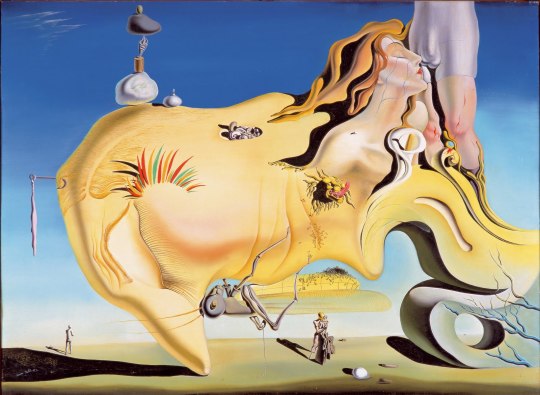
El gran masturbador, 1929
As the politics of war was at the forefront of the Surrealist debate, Breton expelled Dalí from the surrealist movement in 1934 because of differing views on General Franco and fascism - fun times.
Jan Svankmajer
Many of those familiar with his work regard him as either the most significant movie maker active today or a source of nonsense – an attitudinal contradiction that has greeted and continues to be associated with, all the great artist of surrealism. His work typically uses clay and other types of stop-motion animation, puppetry and live action to create a surreal feel throughout his work, which is extremely entertaining. He takes the unwritten rule of pushing movie making to almost breaking point. He is a cult movie maker whose worldwide “cult” is larger than the following of many mainstream directors. When Jan Svankmajer creates a new movie it causes great excitement within many different countries. He has won many movie awards, even though it does not follow the commercial Hollywood ideology.
Due to the fall of the Soviet Union, Jan Svankmajer was able to study the surrealists in more detail, especially in the surrealist Luis Bunuel. His first piece of work was as a director and designer in Liberec with the Czech State Puppet Theatre. His first movie experience was as a puppeteer when he was employed by Emil Radok. This work was a major inspiration for Svankmajer version of the Faust legend.
youtube
He married a surrealist painter called Eva Svankmajerova and she has been an inspiration on his work to this day. He left the Magic Lantern Theatre to make his first short film called ‘The Last Trick’. His second short film used mundane objects in a strange juxtaposition style which is strongly associated with the surrealists. This movie started in a very down to earth way where a man unlocks a room, and sits down at an organ and takes a bite on an apple and begins to play. Even here the apparent naturalism is overthrown. Why the organ should be locked away in a seemingly deserted house and why should the organist be initially wearing street clothes over his performance costume.
youtube
In the same year he went to Austria to create a short film called a ‘Game with Stones’. This film consists of an old musical toy that provided the sound accompaniment to a set of animated sequences, where stones drop from a bizarre gadget arranging and rearranging themselves. Even though the pattern does not make sense on its own if you put all the patterns and sequences together it could represent the evolution of human life and the destruction of human life.
Walt Disney Studios
One of the most surreal scenes from Walt Disney was in the film Dumbo with the Pink Elephants, when Dumbo hallucinates when he blows a giant bubble into the air that turns into pink elephants.
youtube
The elephants then duplicate into other elephants by blowing bubbles through their trunks. The trunks transform into snakes attached to the elephants, and then two elephants mirror each other and then explode apart.
The elephants’ heads are made into a body which starts to walk. The elephants’ eyes turn into pyramids and an elephant-like camel creature walks through them, and then the camel turns into a cobra and then into a lady. Then the blue and pink elephants go ice skating. Finally, it starts to rain elephants that turn into clouds.
Studio Ghibli
Studio Ghibli uses many common themes and motifs throughout their works, for example, they include female leads which are usually young girls or sweet old ladies. Sometimes these two themes are combined because in ‘Howls moving castle’ a young female lead is put under a spell by a witch that makes her turn into a sweet old woman. Some of the other themes that Studio Ghibli uses in its works are aviation, trains and characters that take on multiple forms and bird-like creatures.
Throughout their films, the male characters are misunderstood which is unusual because, in the American film industry, it is usually the other way round. One of the things that make Studio Ghibli’s themes are quite exciting is that in almost all of their films the enemy is not clearly defined.
4 notes
·
View notes
Quote
au bûcher en feu où grillait nue la sorcière je me suis amusé du bout des lèvres de cette après-midi d'arracher doucement avec mes ongles la peau à toutes les flammes à une heure cinq du matin et plus tard maintenant trois heures moins dix mes doigts sentaient encore le pain chaud le miel et le jasmin
Pablo Picasso - mardi 5 novembre 1940
8 notes
·
View notes
Text
Paul ELUARD — LE VISAGE DE LA PAIX 🕊
I
Je connais tous les lieux où la colombe loge
Et le plus naturel est la tête de l’homme.
II
L’amour de la justice et de la liberté
A produit un fruit merveilleux
Un fruit qui ne se gâte point
Car il a le goût du bonheur.
III
Que la terre produise que la terre fleurisse
Que la chair et le sang vivants
Ne soient jamais sacrifiés.
IV
Que le visage humain connaisse
L’utilité de la beauté
Sous l’aile de la réflexion.
V
Pour tous du pain pour tous des roses
Nous avons tous prêté serment
Nous marchons à pas de géant
Et la route n’est pas si longue.
VI
Nous fuirons le repos nous fuirons le sommeil
Nous prendrons de vitesse l’aube et le printemps
Et nous préparerons des jours et des saisons
À la mesure de nos rêves.
VII
La blanche illumination
De croire tout le bien possible.
VIII
L’homme en proie à la paix se couronne d’espoir.
IX
L’homme en proie à la paix a toujours un sourire
Après tous les combats pour qui le lui demande.
X
Feu fertile des grains des mains et des paroles
Un feu de joie s’allume et chaque cœur a chaud.
XI
Vaincre s’appuie sur la fraternité.
XII
Grandir est sans limites.
XIII
Chacun sera vainqueur.
XIV
La sagesse pend au plafond
Et son regard tombe du front comme une lampe de cristal.
XV
La lumière descend lentement sur la terre
Du front le plus ancien elle passe au sourire
Des enfants délivrés de la crainte des chaînes.
XVI
Dire que si longtemps l’homme a fait peur à l’homme
Et fait peur aux oiseaux qu’il portait dans sa tête.
XVII
Après avoir lavé son visage au soleil
L’homme a besoin de vivre
Besoin de faire vivre et il s’unit d’amour
S’unit à l’avenir.
XVIII
Mon bonheur c’est notre bonheur
Mon soleil c’est notre soleil
Nous nous partageons la vie
L’espace et le temps sont à tous.
XIX
L’amour est au travail il est infatigable.
XX
C’est en mil neuf cent dix sept
Et nous gardons l’intelligence
De notre délivrance.
XXI
Nous avons inventé autrui
Comme autrui nous a inventé
Nous avions besoin l’un de l’autre.
XXII
Comme un oiseau volant a confiance en ses ailes
Nous savons où nous mène notre main tendue
Vers notre frère.
XXIII
Nous allons combler l’innocence
De la force qui si longtemps
Nous a manqué
Nous ne serons jamais plus seuls.
XXIV
Nos chansons appellent la paix
Et nos réponses sont des actes pour la paix.
XXV
Ce n’est pas le naufrage c’est notre désir
Qui est fatal et c’est la paix qui est inévitable.
XXVI
L’architecture de la paix
Repose sur le monde entier.
XXVII
Ouvre tes ailes beau visage
Impose au monde d’être sage
Puisque nous devenons réels.
XXVIII
Nous devenons réels ensemble par l’effort
Par notre volonté de dissoudre les ombres
Dans le cours fulgurant d’une clarté nouvelle.
XXIX
La force deviendra de plus en plus légère
Nous respirerons mieux nous chanterons plus haut.
Ouvre tes ailes beau visage
Impose au monde d’être sage
Puisque nous devenons réels.
Paul ELUARD - Le visage de la paix
Pablo PICASSO-Illustration du «Visage de la paix » ; Éditions du Cercle d’Art, Paris(1951).

1 note
·
View note
Text
« PICASSO ET LES AVANT-GARDES ARABES », À L’ « INSTITUT DU MONDE ARABE », À TOURCOING, JUSQU’AU 10 JUILLET
« Portrait de Dora Maar » (Pablo Picasso/1937) & « Visage d’Homme à la Bougie (Samir Rafi/ 1956) © « IMA »-Tourcoing« J’aurais aimé être maure ou oriental. Tout ce qui touche à l’Orient me séduit. L’Occident et sa civilisation ne sont que les mietes de ce gigantesque pain qu’est l’Orient« , déclara Pablo Picasso (1881-1973), ce propos étant rapporté par Geneviève Laporte, dans « Si tard le…

View On WordPress
0 notes
Text
Quelque part en Catalogne
S’enfuir à l’autre bout de la France, par le train, un train lent qui laisse le temps au paysage de s’étaler de part en part, quelque part au milieu de la France, entre Sète et Narbonne, des étangs à perte de vue qui scintillent sous le soleil naissant d’avril, ce maudit mois d’avril, quelque part entre deux attaches, quelque part entre deux dépendances, suspension. On retient son souffle, la tête dans les bras, appuyée sur la tablette, le regard tourné vers l’extérieur. Suspendue dans l’espace.
S’enfermer dans une chambre-cellule, des livres à portée de main, sans rien d’autre que le silence, parfois le gémissement d’un chien, quelques arbres, des fleurs qui traversent les fenêtres, le soleil qui balaye le lit au petit matin. La lecture comme seul refuge pour poser des barrières dans ce crâne, en travers de cette pensée qui s’entête dans une déclinaison infinie d’obsessions malignes, refuge lancinant du devoir à faire, tenir, toujours tenir la ligne de conduite pour réussir ce qu’on a entrepris pour soi-même. Travailler, mais se défaire du manteau de plomb de l’épuisement latent. Détacher le poids des paupières. Se défaire de la somme de contrariétés mises à la chaîne, comme autant de boulets qu’on s’accroche aux pieds, accompagnant comme des grelots les espoirs lassés des amours avortés, pris dans les filets de l’attachement stérile à des êtres qui vont partir, ou qui appartiendront bientôt à l’univers passé des rues parcourus cent mille fois, où les petits fantômes ancestraux s’attardent, donnant la main à des fantômes plus grands, balayés par les marteau piqueurs du temps. Mais dans cette cellule sans barreaux, ouverte sur les chants d’oiseau et le vent des montagnes, dans cette maison avec jardin appartenant au même passé auquel on voudrait s’arracher, paysage du paradis perdu de l’enfance, dans le silence des appareils et des repères envolés, quelque part peut-être peut-on peut enfin respirer.
Silence de cathédrale sous les platanes des villages catalans, où l’odeur du mimosa se joint à celui des cerisiers en fleurs, où les étals dégagent dans l’air cette senteur de savon de Marseille, dans un nuage de couleurs fait d’asperge et de fraises, des tissus mal raccordés aux paellas qui fument dans les grands faitouts noirs, autour desquels les chiens s’attardent, je viens m’échouer là, sur cette terrasse, près de la librairie nichée au coin de la place, où j’ai pu acheter le premier livre, dans le soleil épanoui de dix heures, quand les gens viennent hésiter entre le chocolat chaud et la bière, au sortir de la presse, ou de la boucherie, les enfants agités de tant de vie, que les chats fuient comme la peste, vers le musée Picasso aux longues pierres du souvenir. Encore une fois, je laisserai quelque peu le soleil s’emparer de ma peau, la serrer comme il le sait faire, me faire sentir sa morsure qui m’arrête toujours, dans le silence des rues pavées de Céret, où les oliviers gardent avec ferveur l’église cachée au bout de la ruelle, retenant mon coeur dans un espace-temps dilaté, loin de mon angoisse et de mon ennui des après-midi sans fin, loin de ma chambre aux quatre murs qui me fixent sans cesse, et pressent mon coeur dans l’attente infinie d’un amour absent.
Et cet amour chimérique aux reflets abricots, à la peau tannée et aux doigts courts qui parcourent toujours ma gorge, insaisissable et qui me saisit, cet amour idéalisé et détesté qui me rattrape à l’autre bout de la France, même aussi loin des quatre murs et des rues trop souvent piétinées. Cet amour aveuglant qui me sépare de moi-même et me remplit de colère, qui me fait rejeter jusqu’à l’odeur de paella et le goûts des olives trempées dans l’huile, jusqu’au croustillant du pain cuit au four et l’odeur du mimosa. Je le tuerai cet amour, je le tuerai. Mais j’arracherais ma peau pour qu’on me prenne dans ses bras. J’arracherais n’importe quoi pour qu’on me dise ça ira, ça ira. Un jour je monterai sur les platanes, la peau tannée, la peau pleine de soleil, dégagée de l’obsession de toi qui m’anime et m’enrage. Sur la pierre, et de la montagne à la mer, Ça ira, ça ira.
#littérature#amour#catalogne#odeurs#partir#lecture#lit#soleil#lumière#Catalunya#sud#sud de la France#France#coeur#blessure#douleur#tristesse#déchirure#angoisse#suspension
8 notes
·
View notes
Text
Lessons of war
Matisse is known as a joyful artist - and yet he painted the last century's most pessimistic painting, The Piano Lesson.
Modernist manifestos tend to be full of radical rhetoric, but Henri Matisse's Notes of a Painter is a precise, sensitive analysis of his own work in which he says that what matters to him is expression. He doesn't mean the emotion communicated by a passionate face, but that conveyed by the whole painting: "The entire arrangement of my picture is expressive: the place occupied by the figures, the empty spaces around them, the proportions, everything has its share."
The Piano Lesson, a 1916 canvas 8ft tall and almost 7ft wide that is one of the glories of Tate Modern's Matisse Picasso show, is a textbook example of what Matisse is talking about. In it Matisse's son Pierre sits practising at the family piano in the home Matisse bought in the Paris suburb of Issy-les-Moulineaux. Pierre is made to look younger than he actually was - he was 16 - as part of an ensemble of effects designed to heighten and distil feeling. The placing of the figures - one of them hallucinatory - is full of tension. Pierre seems oppressed by the scale of this big painting. Above him, a woman supervises his practice from a stool. Her blank, watching face is sinister, even when we realise that this is merely one of Matisse's paintings, his 1913-14 work Woman on a High Stool. Pierre is pinned between this phantom observer and the sharp spear of the metronome, whose violent point is repeated in the triangular fall of shadow that obliterates a quarter of his face.
Greyness dominates and oppresses the picture, and it perversely demolishes pictorial logic, as a depressive mood might distort one's sense of reality. Thus the same grey colours the view outside the window, the walls and floor of the living room, and even the torso of the woman on the stool - to the extent that it takes time to feel your way to seeing the room as a room, the window as a window. Only Pierre himself is a fleshy, human survivor of this miasma, along with tokens of life: the bronze nude in the corner, the candle on the pink piano top and, like a torch beam, the ray of green garden that cuts desperately across the grey world.
Everything about The Piano Lesson exemplifies Matisse's own description of his art perfectly, except that the mood it creates is opposite to the ones we associate with him - the unbridled joy of his paintings, the bliss of his paper cutouts. The colliding, fragile, not-quite-touching areas of green and pink in The Piano Lesson, the glimpses of Matisse's sensuous world, are the most painful of all - reminders of life like the stirrings of spring in TS Eliot's The Waste Land.
Eliot is not what we think of when we think of Matisse - nor any other of the 20th century's memorable visions of hell. While Matisse painted The Piano Lesson, Marcel Duchamp was at work on The Bride Stripped Bare by Her Bachelors, Even, his allegory of modern love as masturbation; Giorgio de Chirico was imagining Europe as a dead afternoon in a depopulated piazza. Modern art, whose first stirrings had been rapturous - most of all in the fauvist art that Matisse created in the 1900s - was turning into a desolation. Matisse is generally regarded as having set himself apart from this anguish. His painting is seen as conservative in comparison to the subversion of Duchamp, Picabia and dadaism - the anti-art that rejected bourgeois civilisation because it had created the mechanistic mass slaughter of trench warfare.
And yet it was Matisse who created the most insidiously pessimistic painting of the 20th century: The Piano Lesson. In this completely unexpected painting, Matisse paints the death of his own art. Soon afterwards he left Paris, settling in the south and not really making a comeback until the end of the 1920s. It's an elegy for a way of life, one that Matisse felt no longer made sense - even though in The Piano Lesson he offers a last, desperate justification for the French bourgeoisie.
Or perhaps it's all a joke, a parody of modern art, a satire on its melodrama, a dismissal of Matisse's self-styled revolutionary younger contemporaries. The Piano Lesson is so full of references to creativity that it is often seen as an allegory for Matisse's art. Matisse identified with music, as is revealed not just by his fiery decorative panel Music and later his Jazz series, but also by the fact that he played the violin and sometimes a mechanical organ on which, as his biographer Hilary Spurling relates, he once delighted his students by performing the whole of Beethoven's Fifth Symphony. He was keen for his children to learn, making Pierre play the violin as well as the piano - his picture Violinist at the Window also depicts Pierre.
The Piano Lesson may indeed be an allegory for creativity. Through the tedium of practice, you attain the power to create beauty - the tantalising erotic promise of which is in front of Pierre if only, instead of looking blankly bored at us, he would look at the bronze nude in the left corner, art made with effort, offering joy as work's reward. But there's something excessive, morbid, about the scene that seems to go beyond a rationalist interpretation. This could be mocking how Pierre feels, how, made to practise the piano for half an hour before going outside, he feels that all life's joy has been stolen while he has been in here, in a grey fog, so that even the woman in the painting seems like an evil oppressor. But his paranoia might also have a metaphorical, satirical quality. Like Pierre, Matisse's contemporaries, with their cubist and futurist rhetoric, look younger than they are, and their polarised vision of the world - revolutionary modern art confronting a dead cultural and social order - is paranoid, melodramatic.
The Piano Lesson is a painting about modern art, made in direct response to cubism. In the mid-1910s, as Picasso was turning away from the sombre colours and rigorous destruction of visual conventions of early cubism to create more playful, decorative cubist pictures, Matisse started to experiment with cubism's quasi-mathematical emphasis on structure in paintings such as View of Nôtre Dame (1914) - pictures that are odd, slightly funny, as if he were pastiching a style that he finds uncomfortable. His jagged portrait of his daughter Marguerite in cubist mode is also slightly absurd. The Piano Lesson is Matisse's most serious, successful use of cubist techniques to flatten and compress space. By learning from Picasso, Matisse is able to make his own living room seem a depthless conundrum of existential terror. And yet even here he is parodying Picasso, or rather parodying the lesser lights of cubism, the so-called salon cubists, who used cubist innovation as a signifier of the new, mixing it up with more conventional figuration in paintings such as Jean Metzinger's At the Cycle Track (c 1914). These pictures, charmingly, celebrate the modern world - bike races, planes, the Eiffel Tower - by scattering around cubist planar effects. And not only cubists. A slightly different version of the same rhetoric of the new was concocted as futurist painting.
In The Piano Lesson, Matisse reverses that rhetoric. He takes modern art's instantly recognisable tics and tropes - the planes of colour of cubism, its distortion of space and quotation of words in paintings, emulating signs and newspapers - but instead of making them into a celebration of the modern world's energy, he turns them into images of modern society's oppressive rationality. Most of all, he sees the discipline and militarism of modern society as becoming indistinguishable from private life. Matisse later told Picasso that during the first world war the rival French units of military camouflage painters had called themselves the Picasso and Matisse units. You might detect a shame here, a sense that modern art did not liberate.
The grey in The Piano Lesson is easily seen as a military grey. At the time Matisse painted this, his relatives in northern France were living under German occupation. Far from dealing overtly with the war, this painting suggests a world before the war - it might depict a French middle-class home at any time since the 1860s. The ordinary affluence portrayed here is made explicit by Matisse in his jokey inversion of the way Picasso incorporated markers of modern, street-smart life through beer brands or collaged newspaper headlines. Matisse makes the name of the piano manufacturer visible: Pleyel, a classy yet popular French manufacturer of pianos since 1807. It sets the painting back in time, as Pleyel pianos were associated with 19th-century music - Chopin was in effect sponsored by them, playing at their salons. Liszt, Debussy, Grieg and, contemporary with this painting, Ravel and Stravinsky (who helped design a new model) were also connected with Pleyel. In this painting, though, the brand signifies the typicality of the scene.
It is possible to view the painting romantically: as an assertion that this life, and Matisse's art, will go on. But the picture is chillier than that. It is more that the boy is being compressed, chopped into shape by society, forced to follow the metronome, to play in time, and offered in return the lure of the bronze nude. We're not so far after all from Duchamp's The Bride Stripped Bare. And Matisse goes further than the dadaists. Where they proposed using a Rembrandt as an ironing board, Matisse suggests that modernism - and its latest fashion, cubism - is itself part of the deadening cultural logic of industrial, capitalist, warmongering society. Matisse's older son Jean was taken into the army in 1917, Pierre in 1918.
The metronome in this painting is stone-coloured and looks like nothing so much as one of the pyramid tombs painted by Poussin (Matisse studied Poussin in the Louvre). It is death's beat, the march to the grave, that rules The Piano Lesson - the time the boy is forced to accept, and which Matisse, an arcadian subversive, spent his life trying to slip out of into the free realm of art. The fascination of this painting is that it shows Matisse's belief in art breaking down; he momentarily admits defeat, and in that moment says more about the 20th century than any of modern art's more generally cited apocalyptic statements.
~ Jonathan Jones · Thu 2 May 2002.
0 notes

